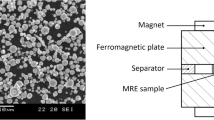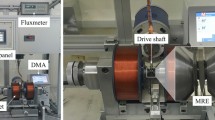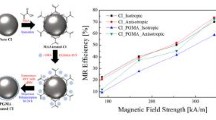Abstract
This article focused on the influence of additional silicone oil as an plasticizer additive in a magnetorheological elastomer (MRE) upon its rheological properties. Here, a silicone rubber is used as a base material of the MRE with CIPs act as the filler. Silicone oil (SO) as a plasticizer is added to the base ingredients to improve the viscosity and dispersion of magnetic particles and enhance the MRE properties. Various tests comprised of magnetic, morphology, and rheology tests were conducted for MRE characterization purpose. The results showed that the addition of SO on the MRE had increased 19% of magnetic properties compared to non-SO based MRE. Dispersion of magnetic particles is improved by the addition of SO as observed through Low Vacuum Scanning Electron Microscope (LVSEM). In rheology test, both absolute and relative MR effects were increased by 0.3 MPa and 343%, respectively, with the incorporation of 15 wt% SO. The introduction of SO has proven to resolve the agglomeration issues in isotropic MRE which degrade performances of MRE application devices and systems.
Access provided by Autonomous University of Puebla. Download conference paper PDF
Similar content being viewed by others
Keywords
1 Introduction
Magnetorheological elastomer (MRE) is smart materials whose rheological properties can be controlled by the applied external magnetic field. Under a stronger applied magnetic field, the MRE perform a higher stiffness. Because of their unique properties, MRE have recently been used in a broad range of possible applications such as vibration absorbers [1], sensing devices [2] and morphing structure [3]. Advantage of MREs is no need container or seals to store or prevent leakage as compared to magnetorheological fluid (MRF) [4, 5]. The MR effect, which calculated from the storage modulus is frequently adopted to evaluate the MRE performance [6]. The main components of MRE was magnetically polarized particles, non-magnetic matrix, and additives. Common matrix materials for MREs include silicone rubber [7], natural rubber [8] and polyurethane (PU) rubber [9]. MREs are often classified into two different type depending on the curing process which are isotropic and anisotropic [10]. Isotropic MREs can be characterized by the randomly distribution of magnetic particle in the matrix. Meanwhile, anisotropic MREs are curing under a strong magnetic field resulted of chain-like arrangement of magnetic particles in a matrix.
In term of particles type, carbonyl iron particles (CIPs) were used as the magnetic particles for the MRE due to their high permeability, low remnant magnetization and high saturation magnetization. Lokander and Stenberg [11] have shown that the maximum MR effect on MRE has been reported to be achieved when the iron particle fill rate at about 70 wt%. It is known that higher particle loading in MRE would lead to higher storage modulus and enhanced both absolute and relative MR effect. However, too many particle loadings will increase the viscosity of polymer composite, significantly, would result in higher initial storage modulus. This would reduce the corresponding MR effect of the MRE. Therefore, to reduce the respective initial storage modulus, plasticizers are introduced to the MRE. Gong et al. [12] and Tian and Nakano [13] agreed that the movement of the magnetic particles is governed by the elastomer matrix. In this way, softer matrices obtained by adding plasticizers cause an increase in the MR effect by providing lower zero-field moduli and improving the interaction between CIPs.
Therefore, in this study, presence of SO in the MRE is believed to improve the interaction between particles due to less restriction from the plasticized-matrix. Consequently, the main technical contribution of this work is to solidly investigate the influence of SO on the magnetic properties and morphology of the CIPs in the matrix. The shear storage modulus and MR effect were further investigated using a rheometer.
2 Fabrication of MRE
The MRE samples used in this work were prepared by compounding CIPs having an average diameter of 6 μm (BASF, type OM) and room temperature vulcanization (RTV) silicone rubber. The RTV silicone rubber in the form of liquid was added with CIPs content of 70 wt% and silicone oil (SO) content of 15 wt% and mixed homogeneously using a mechanical stirrer for 10 min. To prepare the isotropic MRE samples, the compounding was molded into a customized mold for two hours at room temperature with 1.1 mm thickness (Fig. 1). MRE sample without SO also prepared as a benchmark to the MRE with 15 wt% SO. The magnetic characteristics of the fabricated MREs were measured using the vibrating sample magnetometer (VSM). Meanwhile, the microstructure observation was performed using low vacuum scanning electron micrography (LV-SEM) at an accelerating voltage of 15 kV with 1000 times magnification. The influence of the ramped magnetic flux on the storage modulus of MRE samples was measured by the rheometer (Anton Paar, Physica MCR 302, Germany). The samples were evaluated under constant strain amplitudes of 0.01% and at excitation frequency of 1 Hz.
3 Results and Discussions
3.1 Magnetic Properties of MRE
Figure 2 illustrates the magnetization curves of isotropic MRE samples with and without SO content. It is apparent that the magnetic properties of isotropic MREs with and without SO are induced when subjected to the application of magnetic field. The magnetization curves reveal narrow magnetic hysteresis loops for both samples. This fact indicates that both MREs exhibit a soft magnetic characteristic. The trend of the graph is similar for both samples in such a way that the magnetization curves are increased dramatically up to certain magnetic field intensity, approximately 500,000 A/m. Consequently, the slope becomes slender as the particles dispersed in the MRE samples reached their saturated condition as the value of the saturated magnetization (Ms) is obtained. The saturated condition refers to no increment of magnetization when all the magnetic moments in magnetic domains are aligned toward the direction of magnetic field intensity. Unless the magnetic field is released, the magnetic moments may return to its initial condition. From Fig. 2, the values of retentivity (Mr) and coercivity (Hc) of each sample can be obtained at the vertical and horizontal axes, respectively. The retentivity is defined as a magnetic remanence of the magnetic material that implies a measure of the magnetization which is remained after the applied magnetic field is released.
Meanwhile, the coercivity is a measure of magnetizing force required to drive the reverse magnetization after being saturated. Table 1 presents the Ms, Mr, and Hc at increase content of SO, which are obtained from Fig. 1. Apparently, addition of SO contributes to enhancement of magnetic properties of the isotropic MRE. This is proven by increasing of Ms with SO content as referred to the Table 1. The Ms values presented in Table 1 illustrate that the Ms is increased from 121 to 144 emu/g, for the zero and highest SO content, respectively. Besides, the Mr is also proportionally increased with Ms. However, the values are relatively small because the isotropic MRE with SO exhibits soft magnetic material characteristic. The Hc values for both samples are very close to each other but not identical. This is due the characteristic of soft magnetic materials. The results demonstrate that incorporation of SO in the isotropic MREs with SO can contribute to a potential of altering the magnetic properties by adjusting the content of SO and the applied magnetic field.
3.2 Morphology of MRE
The cross sectioned area surface morphology of isotropic MRE with and without SO are presented in Fig. 3. It can be observed that for the MRE either with or without SO, the CIPs are dispersed randomly in the matrix as shown in Fig. 3a, b, respectively. Apparently, there are significant differences in the distribution of the CIPs in the matrix when SO was added. In the presence of 15 wt% of SO, the distribution of CIPs has improved as no big aggregates can be seen in the fractured surface of MRE as shown in Fig. 3b. Furthermore, from fractography observation, the SO can enhance the compatibility between the CIPs and the silicone rubber matrix as there are no such cavities seen as compared to matrix without SO, indicating that CIPs have been well embedded in the matrix. This is indicating that the introduction of SO has enhanced the distribution and texture of the isotropic MRE.
3.3 Rheological of MRE
The influence of the ramped magnetic flux on the shear storage modulus of MREs was evaluated under constant strain amplitudes of 0.01%, excitation frequency of 1 Hz at ambient temperature. The ramp magnetic flux was realized by driving an electric current from 0 to 5 A in a linear fashion. The flux densities were measured and provided more than 0.8 T for both samples. Figure 4 shows the shear storage modulus under the increasing strengths of the magnetic field for MRE with and without SO. In this work, keeping the CIPs weight percentage of 70% constant, both sample’s shear modulus was increased linearly as the magnetic field increased. This proves that both MREs samples exhibited noticeable increment of MR effects. Even though both MREs samples showed an inclined trend as the magnetic field increased, however MRE with 15 wt% SO showed greatly improvement in the MR effect as shown in Fig. 4b. The MR effect of MRE with SO was 343% (0.3 MPa) under the magnetic field of 0.8 T, almost six times higher as compared to MRE without SO, which only 55%. This is due to the uniformly distribution between particles that greatly influence the magneto-induced modulus which resulted in strong interaction between particles, thus lead to stiffer matrix provided higher MR effect. Meanwhile, the absolute modulus of MRE with and without SO was 0.12 and 0.29 MPa, respectively.
4 Conclusion
The effect of SO as a plasticizer additive on the performance of MREs based on silicone rubber has been experimentally investigated. The addition of the SO helps CIPs to disperse well with only a few agglomerations structures. The experimental results have demonstrated that the addition of SO increase the magnetization by 19%. In terms of rheology, the MRE with SO had the lower zero-field modulus and the MR effect of MRE with 15 wt% SO had increased from 55 to 343% when SO was added to the rubber matrix with absolute modulus of 0.3 MPa.
References
Ginder JM (2001) Magnetorheological elastomers in tunable vibration absorbers. In: Proceedings of SPIE, vol 4331, pp 103–110
Tian TF, Li WH, Deng YM (2011) Sensing capabilities of graphite based MR elastomers. Smart Mater Struct 20
Nguyen VQ, Ahmed AS, Ramanujan RV (2012) Morphing soft magnetic composites. Adv Mater 24:4041–4054
Lian C, Lee K-H, Lee CH (2017) Effect of temperature and relative humidity on friction and wear properties of silicone-based magnetorheological elastomer. Tribol Trans 0:1–9
Shi G, Wang W, Wang G, Yang F, Rui X (2019) Dynamic mechanical properties of FeSi alloy particles-filled magnetorheological elastomers elastomers. Polym Technol Mater 00:1–13
Ge L, Gong X, Fan Y, Xuan S (2013) Preparation and mechanical properties of the magnetorheological elastomer based on natural rubber/rosin glycerin hybrid matrix. Smart Mater Struct 22
Hapipi N, Aziz SAA Mazlan SA, Ubaidillah, Choi SB, Mohamad N, Khairi MHA, Fatah AYA (2019) The field-dependent rheological properties of plate-like carbonyl iron particle-based magnetorheological elastomers. Results Phys 12:2146–2154
Lee CJ, Kwon SH, Choi HJ, Chung KH, Jung JH (2018) Enhanced magnetorheological performance of carbonyl iron/natural rubber composite elastomer with gamma-ferrite additive. Colloid Polym Sci 296:1609–1613
Yu M, Qi S, Fu J, Zhu M, Chen D (2017) Understanding the reinforcing behaviors of polyaniline-modified carbonyl iron particles in magnetorheological elastomer based on polyurethane/epoxy resin IPNs matrix. Compos Sci Technol 139:36–46
Kallio M, Lindroos T, Aalto S, Järvinen E, Kärnä T, Meinander T (2007) Dynamic compression testing of a tunable spring element consisting of a magnetorheological elastomer. Smart Mater Struct 16:506–514
Lokander M, Stenberg B (2003) Performance of isotropic magnetorheological rubber materials. Polym Test 22:245–251
Wu JK, Gong XL, Fan YC, Xia HS (2012) Improving the magnetorheological properties of polyurethane magnetorheological elastomer through plasticization. J Appl Polym Sci 123:2476–2484
Tian T, Nakano M (2018) Fabrication and characterisation of anisotropic magnetorheological elastomer with 45° iron particle alignment at various silicone oil concentrations. J Intell Mater Syst Struct 29:151–159
Acknowledgements
This study was financially supported by the Universiti Teknologi Malaysia under Transdisciplinary Research Grant (Vot No. 06G77) and Professional Development Research University Grant (Vot No. 04E02).
Author information
Authors and Affiliations
Corresponding author
Editor information
Editors and Affiliations
Rights and permissions
Copyright information
© 2020 Springer Nature Singapore Pte Ltd.
About this paper
Cite this paper
Khairi, M.H.A. et al. (2020). Enhancement of Isotropic Magnetorheological Elastomer Properties by Silicone Oil. In: Sabino, U., Imaduddin, F., Prabowo, A. (eds) Proceedings of the 6th International Conference and Exhibition on Sustainable Energy and Advanced Materials. Lecture Notes in Mechanical Engineering. Springer, Singapore. https://doi.org/10.1007/978-981-15-4481-1_28
Download citation
DOI: https://doi.org/10.1007/978-981-15-4481-1_28
Published:
Publisher Name: Springer, Singapore
Print ISBN: 978-981-15-4480-4
Online ISBN: 978-981-15-4481-1
eBook Packages: EngineeringEngineering (R0)








